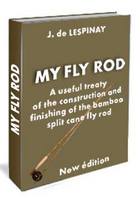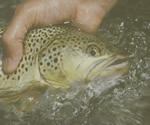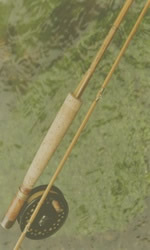Bamboo Fly Rod Building
THE GUIDE MOUNTING
Guide mounting and wraps for fly rods
EXCERPTS CHAPTER X
Throughout the dressing process of a rod, the wraps occupy a reserved place. With the varnish they are the greater part of the author's signature, at least regarding the part immediately visible.
Representing more than a technique or work of passion they display the craftsmanship and beauty of an enthusiast who chooses his yarn with a search for the finest shades and texture, but also endures the elusive search for perfection that is the fate of the designer.
An aesthete would say – "Teach me how to make a proper and sturdy binding and I shall take care of the rest". All right then, I shall try!

10.1 Rod pieces used as colour charts
In order to test the yarn I use a piece of split rod which will allow me to appreciate the pattern of the various coloured wraps and the action of the varnishes on them. This colour chart corresponds to one in a notebook in which I noted the source and the registration of the yarn, as well as the varnish I used.
Insofar as I never use a colour preservative, the colours I see are those of the final result. (Photo. 10.1)
(…)
have no longer this defect, probably due to cost cutting concerns.
HOW TO WIND
Winding is something that seems to be the most difficult for a beginner who wishes to undertake the rod dressing. However I consider this process is one of the simplest during the rod dressing. In the beginning, do not hesitate to make about a score of wasted bindings for training purpose. The piece of rod used as the colour chart can also be used for training.
Winding tables are available, the most well known being the ORVIS. Such tables allow working with the two hands free. Nevertheless, despite having a built in yarn tension system, I am reluctant to use such equipment, as it does not properly address the issue of providing an even and tight yarn tension which is conveniently achieved when the binding is done by hand.
Of course it is possible to obtain beautiful wraps with such a table, and the most beautiful I've seen were made by that means. Nevertheless you will not obtain such a strong tension and above all, not as evenly spread upon the guide foot as that achieved by hand. Moreover the process is long and it is so easy and safer to wrap by our own hands only.
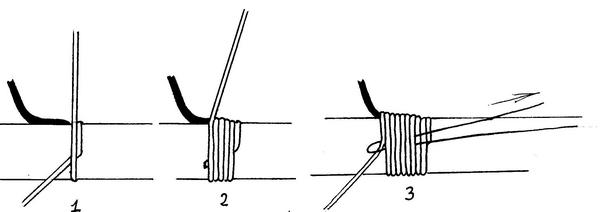
Firstly you must be comfortable, sitting on a chair, the rod held in the left hand (for the right-handed person) and you begin by positioning the guide, which must be properly prepared with the both feet ground, well aligned and lying flat.
(...)
Once the glue has set, you can undertake the actual winding as close as possible to the end of the foot and finishing at the raised section forming the guide aperture.
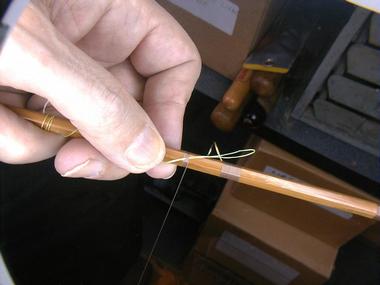
10.4 The buckle getting under the winding
The fingernail must often be used to squeeze and equalize the turns in order to make them as tight as possible.
As a general rule, I leave the yarn reel on the floor in a small box and when I need to release the hand that holds the yarn, I put my foot under it and hold it on the ground.
By raising the rod, a tension is applied allowing the hand to be free for tightening a turn, cutting the excess first blocked under the yarn after a few turns (photo 10.3) and positioning the buckle which is used to pull the yarn under the turns.
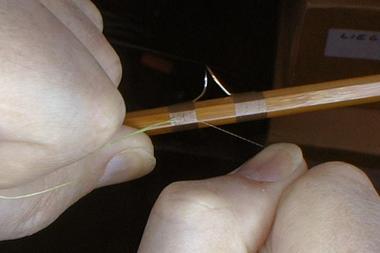
10.5 By pulling the buckle and the attached yarn,
this yarn breaks under the winding
For this buckle an interlaced Kevlar yarn as used in spin fishing, can be used.
This has the big advantage in that it is very fine and sturdy, and able to accurately keep to the shape you give it.
Avoid positioning the Kevlar buckle along the guide foot as there is a space between the ligature and the foot and you are not sure that the yarn will be secured when introduced under the winding by the buckle.
The yarn introduced in the Kevlar buckle must be rather long (about 20 centimetres) as it must give a good hold.
It must indeed be held with a good tension when the buckle draws it under the wrap and when it is in place, in order to be able to strongly pull on the buckle and have the yarn broken under the turns.
With the short wraps the yarn is under the wrap soon after it begins to be wrapped around the rod and there will not be enough turns to cover it.
When the wraps are finished quickly pass them over the flame of an alcohol lamp or gas cooker ring in order to burn the fluffing that is frequently encountered on the surface of the yarn.
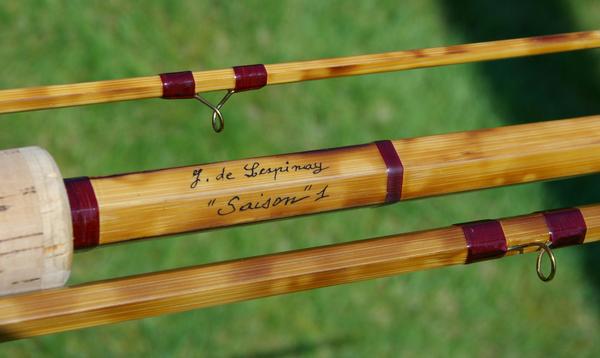
10.6 Wraps on a 12 ft. salmon fly rod
Bamboo fly rod building ©2010
